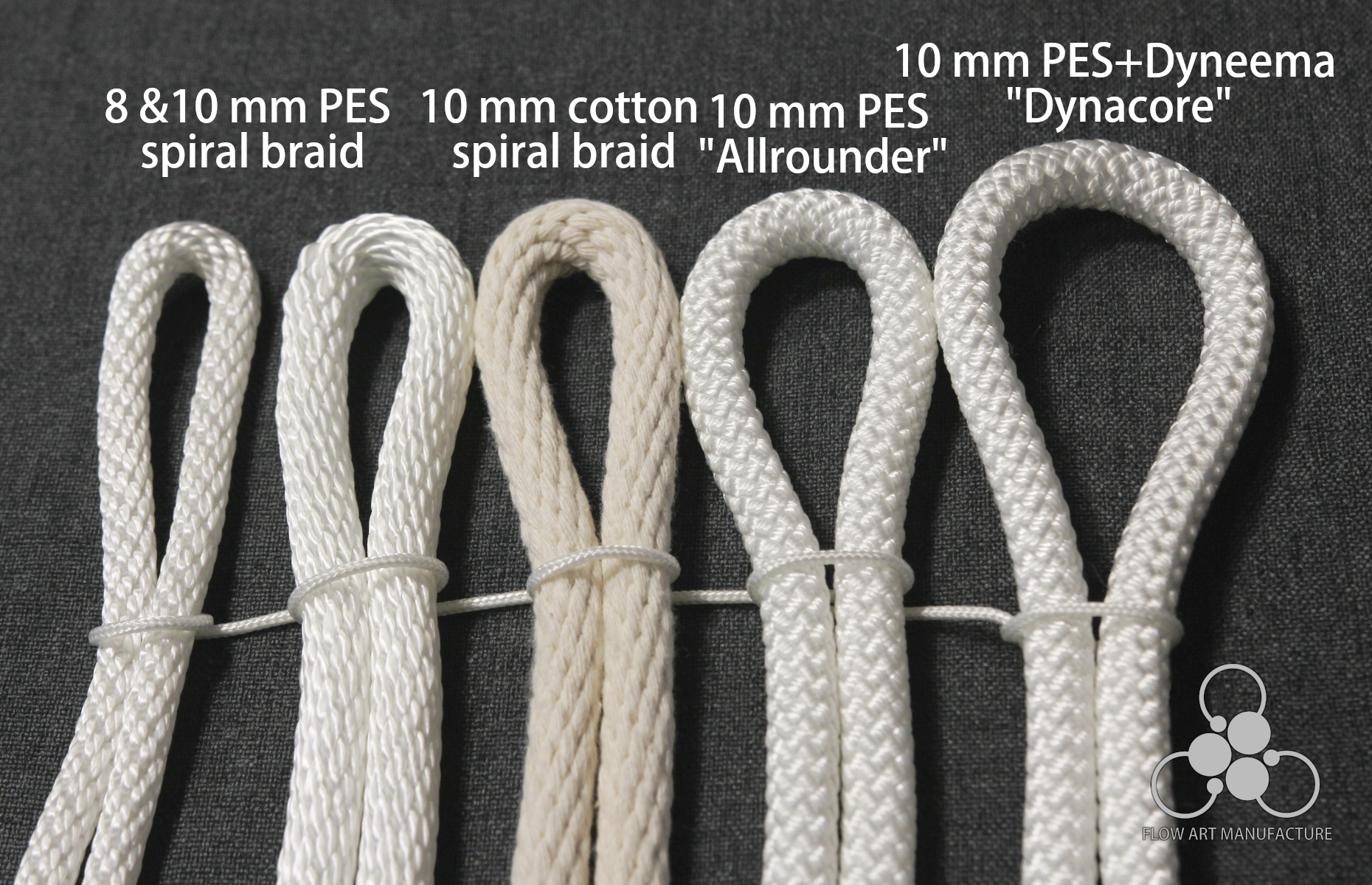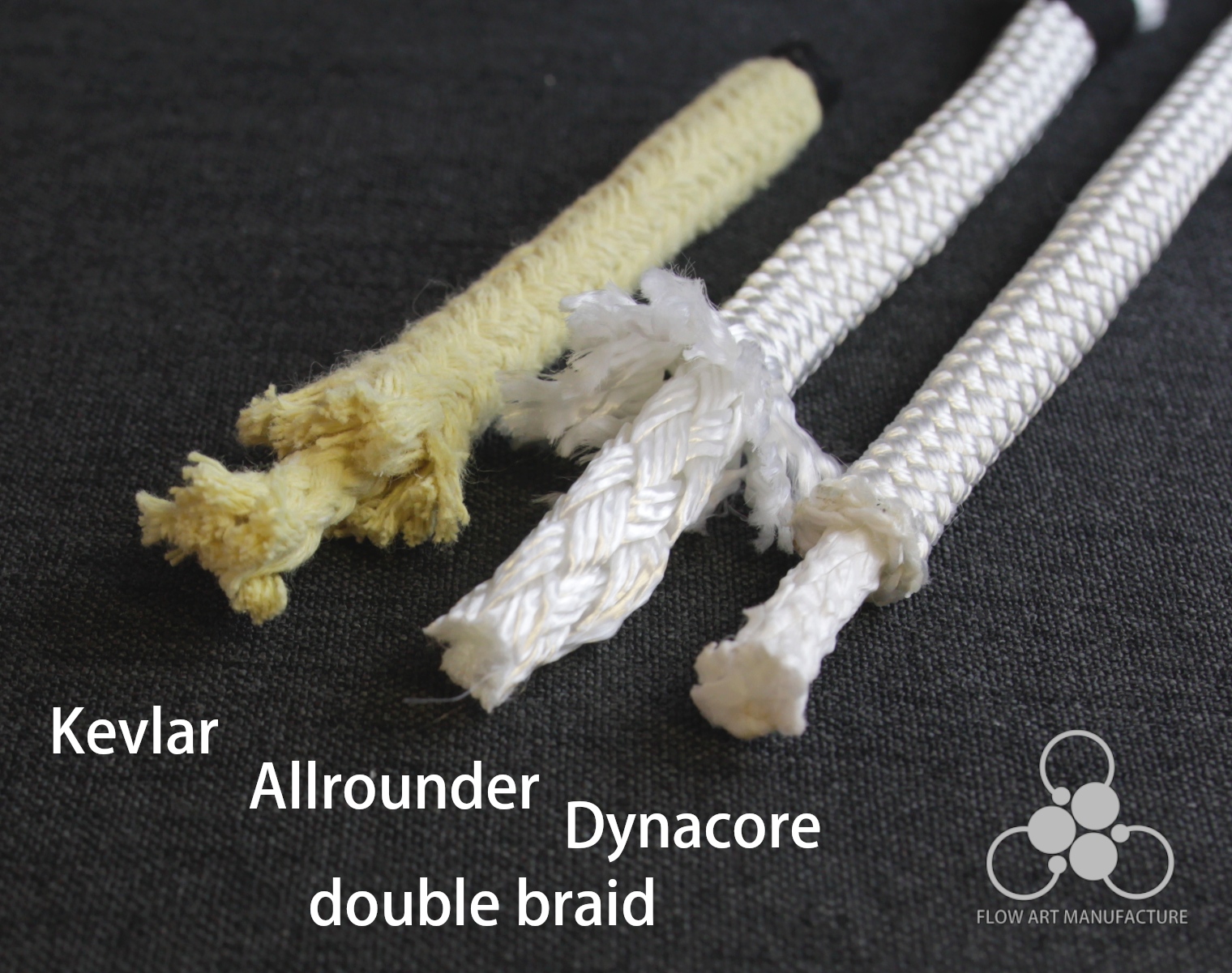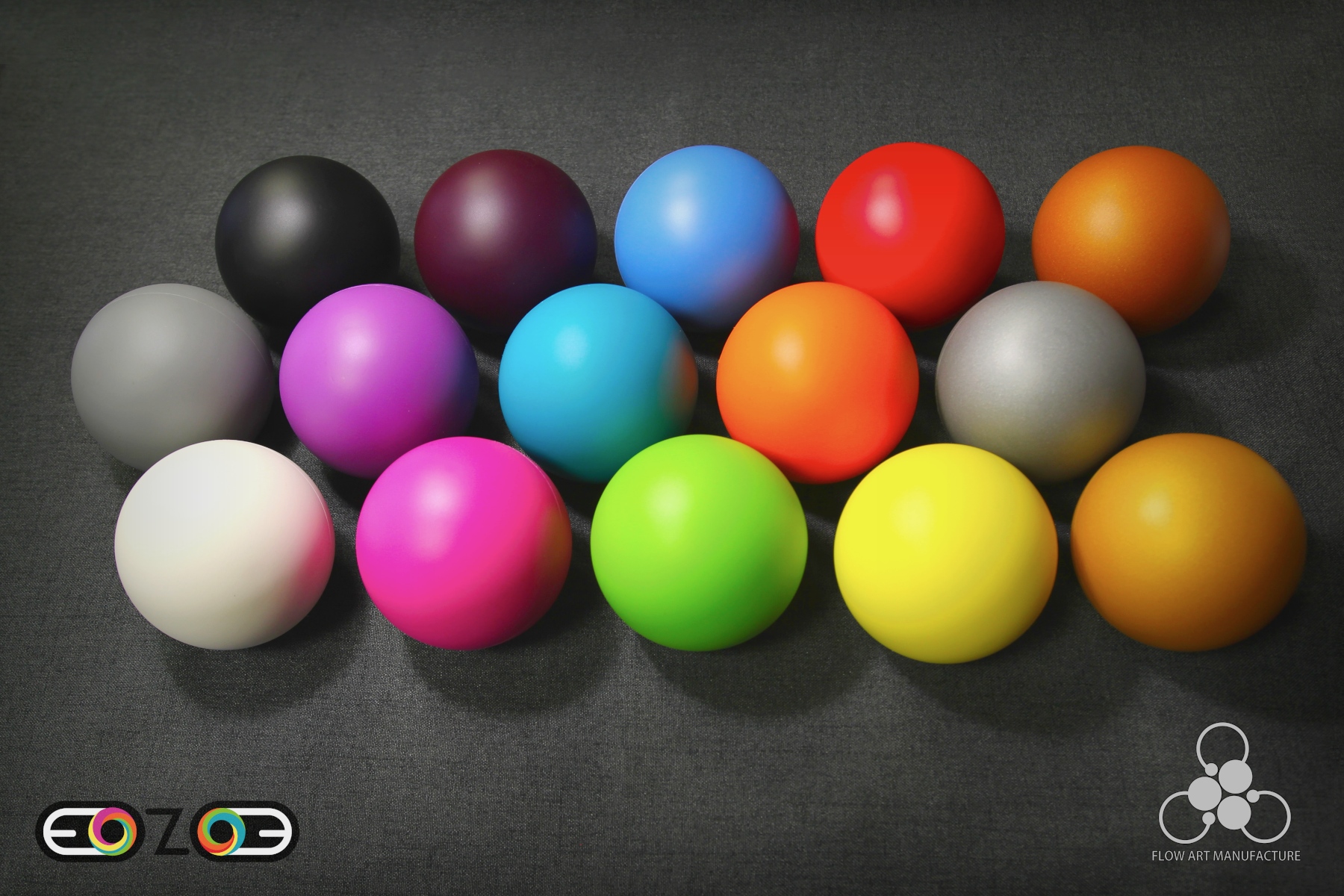Knowledge Base
All components in this shop have been extensively tested by me.
Over the years, through lots of research, trial and error, I gave my best to optimize all components with regard to performance and longevity.
On this site you'll find information about materials and techniques regarding daytime and fire props.
Jump to topic:
Rope Options -
Rope Technology -
Splicing -
Length -
Sustainability - Kevlar Care
Choosing a rope for your Poi
If you are not sure which rope to choose for your contact poi, this table will offer some help:
| rope
|
stiffness |
stretch | spinning | juggling | life-time |
| spiral braid 8 mm |
★☆☆☆ | ★☆☆☆ | ★★★★ | ★☆☆☆ | ★★☆☆ |
| spiral braid 10 mm | ★☆☆☆ | ★☆☆☆ | ★★★★ | ★★☆☆ | ★☆☆☆ |
| cotton | ★★☆☆ | ★★☆☆ | ★★★★ | ★★☆☆ | ★★★☆ |
| Allrounder | ★★★☆ | ★☆☆☆ | ★★★★ | ★★★☆ | ★★★★ |
| Dynacore | ★★★★ | ☆☆☆☆ | ★★★☆ | ★★★★ | ★★★★ |
| Dyneema | ★★☆☆ | ☆☆☆☆ | ★★★★ | ★★☆☆ | ★★★☆ |
More details on each rope:
- Spiral braid: great for spinning, stalls, tangles and whip-catches. Due to its high flexibility not suited to poi juggling. They have a smooth-as-butter hand feel. The 10 mm version tends to high rates of shrinkage (up to 10%). Available in 6-10 mm.
- Cotton rope: natural feeling, great for spinning and also suited for contact meteors. Slightly stretchy, hence not perfectly suited to juggling. Available in 10 mm.
- Allrounder: a true multi-talent, suitable to all spinning styles and poi juggling. A tighly woven mantle of special polyester grants this rope a high life-time. Perfect for beginners as well as pros. Available in 10 mm.
- Dynacore: stiffer than the Allrounder rope due to zero-stretch Dyneema-core, but with the same rugged mantle construction. The perfect rope for poi juggling, this rope shines also for advanced tricks like flats, inverse throws and helis. Available in 10 mm.
- Dyneema: very flexble rope with zero stretch, similar feel as Technora. Available in 6 mm, as well as stiffened to 8 mm.

Rope Technology
Every rope has its own strengths and weaknesses. The properties of a rope depend on two factors: material and braid. The fiber material primarily determines how stretchy, heat-resistant and abrasion-resistant the end product is. You can find out more about materials below. The braiding, i.e. how several fiber strands are brought together to form a rope, determines how flexible, dimensionally stable and durable the rope is.
Braids are divided into two categories - with and without a core. To the ropes without core include the spiral braids and hollow braids. Spiral braids are particularly flexible and low-stretch. Hollow braids offer the great advantage that they can be spliced easily. Splicing is an elegant, knotless and particularly secure connection option. That is why hollow braids made of Technora and Dyneema are the first choice for the production of fire poi and ropedarts.

So-called kern-mantle ropes have a braided sheath and can have a twisted or braided core. A double braid rope has many advantages. For example, the Kevlar wick rope used is double-braided and still holds when the surface is chafed.
For the mantle there are also the variants of 1-ply (1:1) and 2-ply weave. This implies over and then under how many other fiber strands each fiber strand is led. In general, 1: 1 braided ropes have the highes longevity. This is due to the fact that the fiber movement against is limited by the minimized surface and compact fiber structure. Both the Allrounder rope and the Dynacore rope belong to this category. VPC rope, which is popular in the USA , is also made in this type of braiding. The disadvantage of VPC rope is a high shrinkage factor. With the Dynacore rope, this problem is severely reduced by the narrower fiber strands.
Basically, the more dense the braiding, the more durable a rope is. In the case of double-braided ropes, the stiffness is also determined by the degree of filling.

Materials
Cotton - ropes made from this natural fiber have a pleasantly soft grip. The rope is slightly stretchy and has a slight bounce while playing. With regular use, cotton ropes have a limited service life of approx. 2 years due to their low abrasion resistance.
Polypropylene and Nylon - Both materials are popular in making sailing ropes and climbing ropes. A major drawback for use in poi ropes is the moderate abrasion resistance of these materials. After a short time, ropes made from these materials shrink significantly, become stiff and tend to felting.
Polyester - ropes made of polyester are generally very low-stretch and particularly abrasion-resistant. This means that there is no bounce effect when playing and the ropes last a particularly long time.
Dyneema - fibers made of high-mudulus polyethylene (HMPE) are sold under this brand name. This high-tech fiber is particularly low-stretch and resilient that it has replaced steel cables in many applications. Despite this, Dyneema is nevertheless extremely soft and flexible and a popular choice for rope darts and puppyhammers.
Kevlar - This para-polyamide/para-aramid developed by DuPont is known for its high mechanical strength. For fire props, it is used as a wick material because of its heat resistance - the decomposition point is around 500 °C. However, at high temperatures, Kevlar loses its shock resistance. Since the fibers are not UV-resistant, fire props should, if possible, not be stored in direct sunlight.
Technora - As a so-called para-aramid co-polymer, Technora , developed by Teijin, is closely related to Kevlar and is similarly heat-resistant. Technora ropes are usually made from long-strand filament fibers. Compared to the coarse staple fibers, which make Kevlar wick material particularly absorbent, Technora ropes are therefore better suited for Poi tethers.
Splicing
Splicing is a specific technique of the rope handling. With fire poi and ropedarts, splicing creates particularly secure connections without annoying knots. The most important splice here is the so-called brummel splice. The rope is passed through itself twice to form a secured loop to attach to the head. You can find a great visualized explanation of the brummel splice on animatedknots.com.
With Technora fire poi you have the choice between partially and fully spliced Technora ("stiffened Technora"). In the case of a partial splice, an end piece only 15 cm is pulled into the rope. With a full splice, the rope is pulled through itself along the entire length of the rope. This creates a somewhat stiffer rope with a constant thickness. A fully spliced 6 mm rope grows to 8 mm, an 8 mm rope to 10 mm.
A splice can also be used to create a secure connection between two ropes. For fire ropedart leashs, a fireproof lead made of Technora is spliced to the more durable main part made of Dyneema.


Finding the right length
To be honest: there is no such thing as the "right length". Depending on spinning style and preferences, different desired lengths develop. Short poi favor a fast style, very long poi are better suited to calm movements and pendulums. That's why it's exciting to try out a new length every now and then. In general, it is advisable to adapt the length of your poi to your height and arm length, as shown in the diagram. You can either measure the distance between the crook of your thumb and your armpit, or from the crook of your thumb to about 15 cm above the floor. Note: here in the shop all lengths are given as total lengths.
The following rule of thumb applies to a ropedarts: total length = arm span + shoulder height. Alternatively, double the arm span is also a good estimate. With this length you can play most ropedart tricks without the dart head hitting the ground. A longer dart enables multi-layered, more complex wraps, but also requires increased slack control. If the dart is too long, you can vary it with wraps around your hand/wrist.
With meteors, the length depends on the style of play. The appropriate total length for Contact corresponds to the arm span width from fingertip to fingertip. For spinning, the total length should be around two short poi lengths, approx. 120 cm.

Sustainability
For juggling and fire props, we largely rely on synthetic materials. The main reasons are advantages with respect to performance and durability. And as long as there are no alternatives to high-tech materials, such as the fireproof Kevlar for fire props, unfortunately we cannot get past the petroleum processing industry.
That is why it is all the more important to reduce the ecological impact of the materials wherever possible. For example, the PVC stage balls produced éoZoé in France free of plasticizers such as BPA and are thus 100% recyclable. With the exception of Technora and stammt von Play aus Italien. Besonders erfreulich ist auch, dass bei der , all ropes are produced in Germany. The stammt von Play aus Italien. Besonders erfreulich ist auch, dass bei der comes from Play in Italy. It is particularly gratifying that the Dyneema fibers are made using bio-ethylene as a raw material, which is obtained as a by-product of the wood and paper industry. As a result, less CO2 is generated during production and fewer petrochemical derivatives are used.

Care Tips for Fire Props
Kevlar has a reputation for being indestructible and is used for fire props because it can withstand high temperatures. Both are only half true, because like any material, Kevlar has its limits. There are a few helpful tips to increase the lifespan of your fire props:
- Make sure you choose the right fuel. In the German/European fire player community, high-purity lamp oil is used almost exclusively, alternatively so-called Toyfluid (different variants of Isopar) is used. These have fewer harmful impurities, little soot development and a firing temperature that is not too high. If you are not in Germany and looking for the right fuel to use, you can find information on different types of fuel around the world here, a list compiled by Dan Miethke from Spark Fire Dance.
- Give your tools a break. If a fire poi is lit once and then allowed to cool down again, the heat development is limited. But if the poi is soaked and re-lit several times in a row, the surface gets hotter and hotter and the kevlar can char. Thus: better take a break of at least 15 minutes between burns.
- Don't let the poi burn out. The longer your burn, the smaller and ultimately bluer the flame image will be. While the tool is still well soaked, the lamp oil acts like a kind of protective layer: as with a candle, it is not the wick that burns, but the fuel and the wick is not exposed to a lot of atmospheric oxygen at high temperatures. If there is only a little fuel in the wick, Kevlar will also start to degrade. Therefore: it is better to play shorter so that you can benefit from your prop longer!
- Re-soak. Even after extinguishing your prop is still hot. It is therefore advisable to do a quick dip after extinguishing, i.e. a short soaking process. As a result, the head cools down and the fibers are wetted with fuel again. After the last burn of the evening and before you pack your prop back up, it's still better not to re-dip your head. This technique is not advisable with low-flashpoint fuels such as Coleman's fuel!
- Do not completely submerge the head. The Technora on a poi or ropedart should not be soaked with fuel. Therefore only immerse the head 80% when dipping, the wick will still absorb the fuel evenly.
- With the first burn , of course, all these tips applies doubly. It is best to soak your heads completely during the first 2-3 burns until no more bubbles appear. Then limit your burning time to 2-3 minutes and extinguish it early. This helps break in the wick slowly.
- Store dry and protected from sunlight. Kevlar is UV-sensitive and should therefore spend its life protected from direct sunlight. Moisture can also lead to mold growth.
- Store knobs separately. Handles made of silicone or TPU, such as pomgrips, have the annoying property of swelling when they come into long contact with lamp oil. It is not a problem if you get something every now and then. If you pack your fire props, however, a three-bag system is recommended: one for the heads, one for the knobs and the rope and one around it, for safety and as an odor barrier. Of course, you don't have to disassemble your props to do this. But always make sure not to pack your props soaked or hot.
